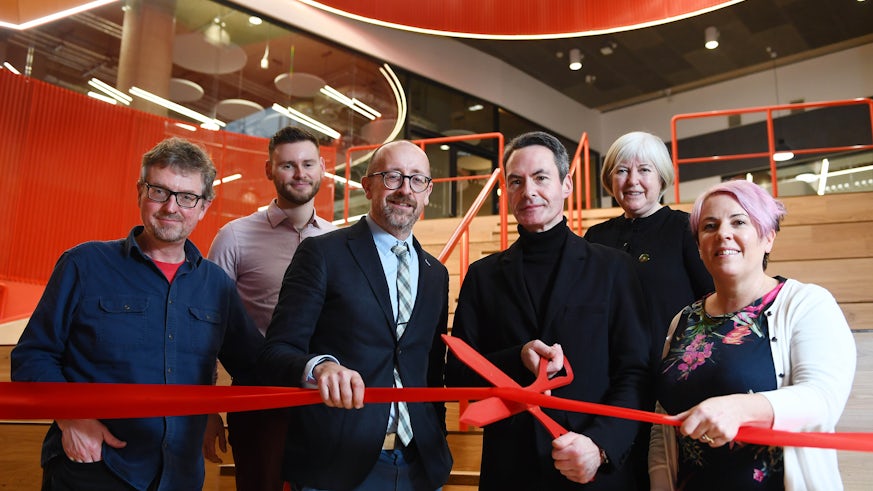sbarc|spark opens new doors
7 March 2022

A new flagship centre where ideas ignite invention opened its doors on St David’s Day.
sbarc|spark – Cardiff’s #HomeofInnovation - brings together researchers, entrepreneurs, student start-ups and academic spinouts in a state-of-the-art building at the heart of Cardiff Innovation Campus.
Featuring collaborative working spaces, a visualisation centre, auditorium and RemakerSpace, the hub provides the seedbed in which Wales can nurture and grow tomorrow’s big ideas as the UK recovers from the COVID-19 pandemic, with dedicated space for student entrepreneurs.
The centre is the vision of Cardiff University President and Vice-Chancellor, Professor Colin Riordan, who sought to create a ‘virtuous circle’ for growth that would attract investment and generate wellbeing by investing in people, places and partnerships.
“sbarc|spark will be a magnet for talented researchers, graduates, entrepreneurs and funders, bringing together stakeholders from all sectors to establish Cardiff University as a powerful engine for growth,” said Professor Riordan.
“It will boost Cardiff’s reputation as a capital for job creation, a source of highly-skilled graduates and a flourishing home of innovation.”
The centre is the largest innovation facility of its kind in Wales, featuring 12,000m sq of floor space across six storeys, with commercial units and lab spaces for spinouts and start-ups in Cardiff Innovations@sbarc - the focal point for Cardiff’s partnerships.
Expert academics from 12 social science research groups - collectively known as SPARK - will share spaces with public, private and third sector partners to create, test and incubate fresh ideas that can help build a better society.
SPARK Director, Professor Chris Taylor, said: “SPARK is dedicated to studying how society works, and our member groups tackle issues ranging from public health and crime to poverty and climate change. The concept of a Social Science Research Park – a first for Wales - has never been more relevant.”

Professor Sally Power, Director of research group WISERD, said: “WISERD@Cardiff is very excited about the prospect of moving into sbarc|spark. As a partnership between five universities – Aberystwyth, Bangor, Cardiff, South Wales and Swansea – WISERD already demonstrates the benefits of interdisciplinary working.
“SPARK will add another dimension to our collaborations. It will enable us to develop new synergies with different researchers, with different specialisms, and in different fields. It will provide state-of-the-art facilities that will support data collection and analysis, as well as access to networks of influence that will maximise the reach and impact of our research. In short, SPARK will enable Wales to stand at the forefront of social science.”
Contractor Bouygues UK sourced more than 70% of site contractors and labour locally during the sbarc|spark build, bringing economic benefits to Wales.
Up to 800 people will eventually work in sbarc|spark. Designed by award-winning architects Hawkins\Brown, the centre stands alongside other specialist hubs: the Translational Research Hub and Cardiff University Brain Research Imaging Centre.
The building brings benefits to the local community. The ground floor will be a public open space with a café, a flexible auditorium for TEDx-style events and an open staircase – the 'Oculus' - designed to drive social engagements and collaborations.
Professor Damian Walford Davies, Deputy Vice-Chancellor, has overseen the delivery of the centre.
“We celebrate the opening of sbarc|spark confident that the vision that inspired it – that of a community of Cardiff University researchers with social and economic wellbeing as their subject and goal, co-located with external partners with innovation in their souls in a building designed to eliminate barriers – will now be lived reality. In words that appear inside the place: ‘Not a silo: see the light slant, scintillating, in?’”


